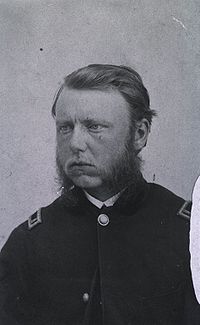Encyclopedia Dubuque
"Encyclopedia Dubuque is the online authority for all things Dubuque, written by the people who know the city best.”
Marshall Cohen—researcher and producer, CNN
Affiliated with the Local History Network of the State Historical Society of Iowa, and the Iowa Museum Association.
MATTHEWS, Washington
Family Ancestry: http://wc.rootsweb.ancestry.com/cgi-bin/igm.cgi?op=GET&db=lacy1002&id=P33
MATTHEWS, Washington. (Killiney, Ireland, June 17, 1843 - Washington, D. C., March 2, 1905) The son of Nicolas Blayney Matthews and Anna Burke Matthews, Washington and his brother were brought to the United States after the death of his mother. He grew up in Wisconsin and Dubuque, Iowa where his father, Dr. N. B. Matthews, began training his son in medicine. He graduated from the University of Iowa School of Medicine in 1864. (1)
Matthews volunteered for service in the Union Army during the CIVIL WAR. His first post was as surgeon at Rock Island Barracks, Illinois, where he tended to Confederate prisoners. (2) After the war, the size of the army was reduced, but Matthews secured a position as a contract surgeon. (3)
Posted at Fort Union in what is now North Dakota/Montana in 1865, Matthews developed an interest in Native American peoples and languages. He would go on to serve at a series of forts in Dakota Territory until 1872: Fort Berthold, Fort Stevenson, Fort Rice, and Fort Buford. He was a part of General Alfred H. Terry's expedition in Dakota Territory in 1867. (4)
While stationed at the Fort Berthold in the Dakota Territory, he learned to fluently speak the Hidatsa language and wrote the Grammar and Dictionary of the Hidatsa and the Hidatsa (Minnetaree) English Dictionary. (5) So important was this study that the University of Iowa awarded Matthews an honorary doctoral degree in 1888. (6) In 1873 Matthews was about to have a dictionary of the Seneca (Native American) language published and an English-French vocabulary of the Mohawk language. (7) He also wrote many articles including "The Human Bones of the Hemenway Collection," "Myths of Gestation and Parturition," "On Measuring the Cubic Capacity of the Skull." (8)
There is some evidence that Matthews married a Hidatsa woman during this time. Her name is not known. There is also speculation and circumstantial evidence that Matthews had a son. (9)
In 1877 Matthews participated in an expedition against the Nez Perce, and again in 1878 against the Bannock. While serving on a prison on Alcatraz Island in San Francisco Bay, Matthews made a study of the Modoc language. (10)
From 1884-1890, Matthews was posted to the Army Medical Museum in Washington, DC. During this time he conducted research and wrote several papers on physical anthropology, specifically craniometry and anthropometry. (11)
John Wesley Powell of the Smithsonian Institution's Bureau of American Ethnology suggested that Matthews be assigned to Fort Wingate, near what is now Gallup, New Mexico. It was there that Matthews came to know the people who would become the subject of his best known work, the Navajo. (12)
His work on the Navajo rejected previous thinking about the complexity of Navajo culture. Matthews referred to Dr Leatherman's account of the Navahoes as the one long accepted as authoritative. In it that writer declared that the Navajo have no traditions nor poetry, and that their songs "were but a succession of grunts." (13)
Dr. Matthews discovered that they had a multitude of legends, so numerous that he never hoped to collect them all: an elaborate religion, with symbolism and allegory; and many prayers and songs relating to all subjects. Matthews is said to have been initiated into various secret Navajo rituals. (14) The Night Chant, originally published in 1902, tells of one of the great nine-day, Navajo winter healing ceremonies. During its course, nearly all the important characters of the Navajo mentioned in legends, are illustrated in sand paintings and impersonated with the use of masks and other ritual objects. Washington Matthews's book contains one of the few extensive descriptions of this important ceremony. (15) He was author of Navajo Weavers for the Bureau of Ethnology to the Secretary of the Smithsonian Institution, 1881-'82. (16)
Matthews was quoted by Charles Darwin in his work on emotion; Matthews is cited with respect to the expression of emotion and other gestures among various peoples of America: the Dakota, Tetons, Grosventres, Mandans, and Assiniboine. Loeseliastrum matthewsii was named after him. (17)
He was the brother of Alphons MATTHEWS
---
Source:
1. "Washington Matthews," Wikipedia. Online: https://en.wikipedia.org/wiki/Washington_Matthews
2. Ibid.
3. "Washington Matthews," State Historical Society of North Dakota. Online: http://ndstudies.gov/gr8/content/unit-iii-waves-development-1861-1920/lesson-3-building-communities/topic-7-telling-our-story/section-3-washington-matthews
4. "Washington Matthews"
5. "Washington Matthews," State Historical Society of North Dakota
6. Ibid.
7. "A Literary Man From Dubuque," Dubuque Herald, April 12, 1873, p. 4. Online: https://news.google.com/newspapers?nid=uh8FjILnQOkC&dat=18730412&printsec=frontpage&hl=en
8. "Dr. Washington Matthews," Online: http://iagenweb.org/boards/dubuque/biographies/index.cgi?read=268558
9. "Washington Matthews"
10. Ibid.
11. Ibid.
12. Ibid.
13. Ibid.
14. Ibid.
15. "The Night Chant," publisher synopses and review. Online: http://www.powells.com/biblio/9780874804911
16. The Project Gutenberg EBook of Navajo Weavers, by Washington Matthews. Online: http://www.gutenberg.org/files/17742/17742-h/17742-h.htm
17. "Washington Matthews"



